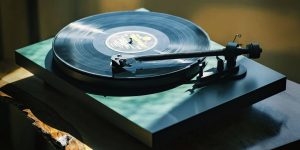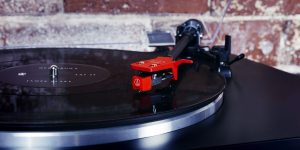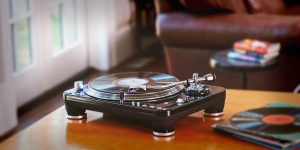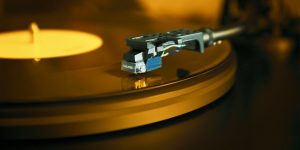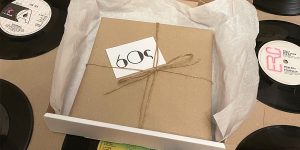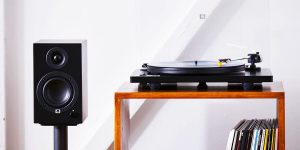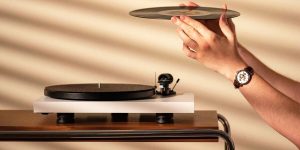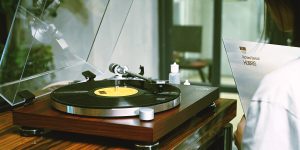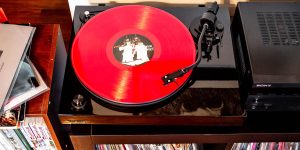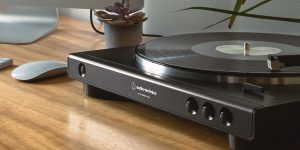While working with Audio-Technica turntables, I’ve always noticed their fairly good performance and affordability. These mid-range turntables are great for beginners and quite suitable even for more experienced vinyl lovers. And with a good pair of speakers, they can really do a lot.
Choosing the best speakers for an Audio-Technica record player is about more than just sound; it’s about finding a pair that complements its strengths and brings out the nuances in your favorite tracks. So, let me help you select a set that aligns with Audio-Technica’s performance and fits seamlessly into your personal listening environment.
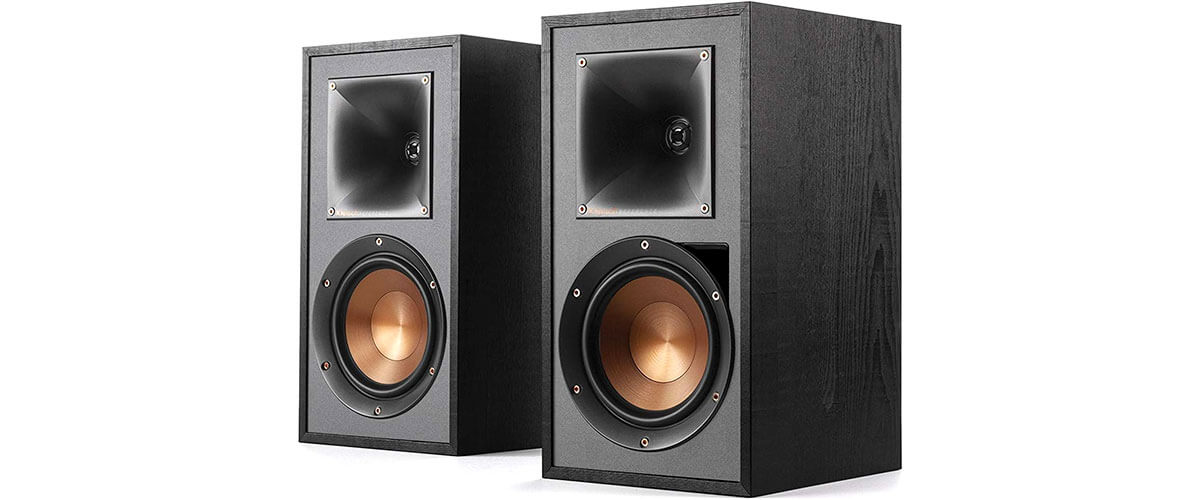
Speakers for audio technica record player comparison table
| Name | Power type | Output peak power | Speakers type | Frequency response | Sensitivity | Review |
|---|---|---|---|---|---|---|
| Klipsch R-51PM best overall | active | 120W | bookshelf | 68Hz-21kHz | 107dBA | Review |
| Edifier R1280T budget | active | 42W | bookshelf | 52Hz-20kHz | 85dBA | Review |
| Klipsch RP-600M II passive | passive | 400W | bookshelf, woofer | 45Hz-25kHz | 96dBA | Review |
| KEF Q150 great alternative | passive | 100W | bookshelf | 51Hz-28kHz | 86dBA | Review |
Powered (active) vs. passive speakers
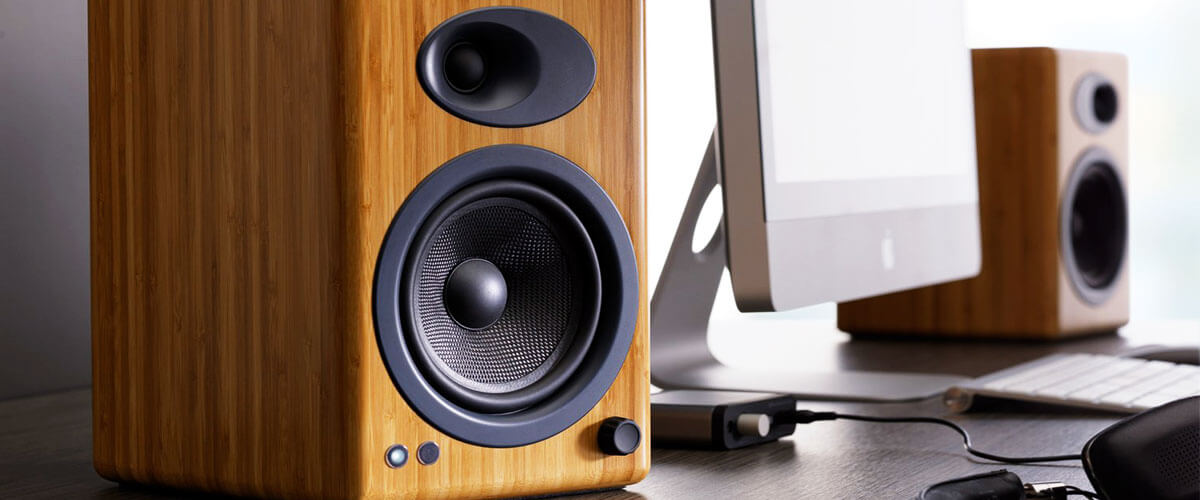
When shopping for speakers, choosing between powered (active) and passive models is a fundamental decision. Active speakers have built-in amplifiers, which means they can directly connect to your turntable without the need for an external amp. This all-in-one solution is perfect for unassuming music lovers and people with limited space. This configuration provides harmonious integration of the amplifier and speakers but loses in sound quality to its passive “counterparts”.
On the other hand, passive speakers require an external amplifier or receiver to power them. This setup offers a customizable audio experience, allowing you to mix and match components to achieve the desired sound quality. It’s an excellent choice for audiophiles who love to tweak and fine-tune their system.
To sum up, when selecting speakers to pair with an Audio-Technica turntable, consider your budget, your musical preferences and most importantly the level of sound quality you need.
Best speakers for Audio-Technica turntable reviews
Powered speakers
Klipsch R-51PM – best overall

I suggest starting with the model I liked the most. Having spent time with the Klipsch R-51PM speakers, I’ve found them to be quite the performers, especially considering their price point. Right from the start, the ease of setup and their relatively compact size were positives that stood out. Klipsch’s design, featuring exposed fasteners and textured wood grain vinyl, coupled with visually appealing copper drivers, adds a touch of elegance to any room.
The speakers boast a range of connectivity options, including Bluetooth, which I found to be effortlessly straightforward to pair. This versatility is a boon for anyone looking to switch between different audio sources easily.
On the sound front, the R-51PMs pack a punch. The bass is powerful, perhaps a tad too dominant for my taste, which might not align with everyone’s preferences. Although there’s an option to tweak the bass levels when using an external subwoofer, direct adjustments on the speakers themselves are limited. This can be a bit of a letdown if you’re after a perfectly balanced audio output right off the bat.

Thanks to Klipsch’s unique LTS aluminum tweeter, the high frequencies are crisp and clear without leading to listening fatigue—an aspect I was initially wary of. This clarity enhances the listening experience across various genres, making tracks like Pink Floyd’s “Sorrow” come alive with an amazing depth.
In my opinion, the Klipsch R-51PM are the best speakers for Audio-Technica turntable owners, considering their strong performance across a variety of music genres, straightforward connectivity, and sleek design — all at a fair price. While the bass levels may lean towards the heavier side for some tastes, the precision of the highs and the depth of sound quality more than compensate. Ideal for users seeking a vibrant listening experience complemented by contemporary conveniences, the R-51PM strikes a perfect balance.
Key specs
- Power type: active.
- Output peak power: 120W.
- Speakers type: bookshelf.
- Frequency response: 68Hz-21kHz.
- Sensitivity: 107dBA.
- Connectivity: wired, wireless (Bluetooth).
- Dimensions, inch/cm: 13×7×8.5/33×17.8×21.6.
- Weight, lb/kg: 10.6/4.8.
Pros
- Robust performance across various music genres.
- Easy and straightforward connectivity options, including Bluetooth.
- Elegant design with visually appealing copper drivers and textured finish.
- Detailed highs and clear sound quality without listening fatigue.
Cons
- Lack of direct bass control without an external subwoofer.
- The pronounced bass may not be ideal for smaller rooms or placements close to walls.
Edifier R1280T – budget
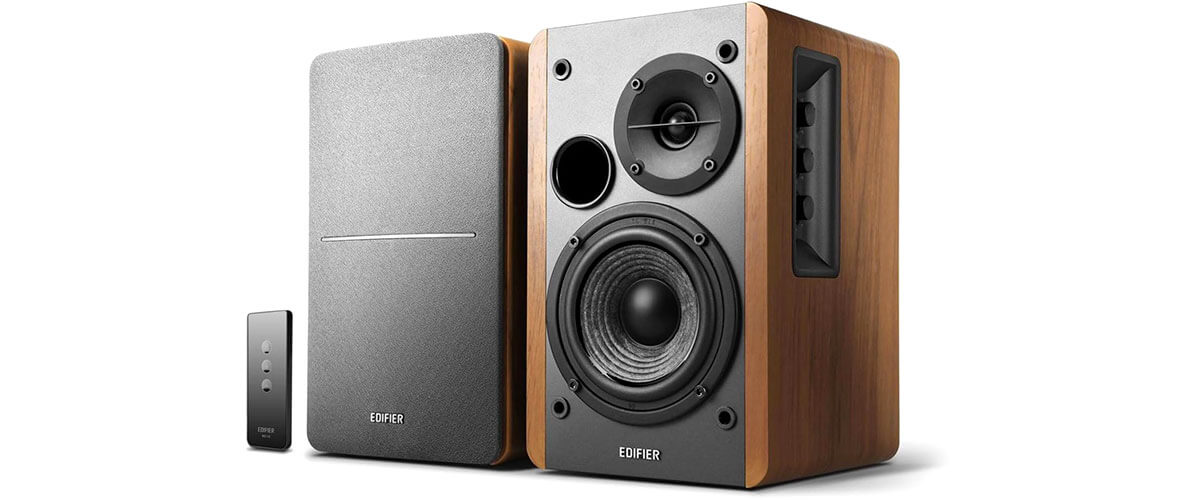
I’ve recently had the pleasure of pairing the Audio-Technica LP60X with the Edifier R1280T speakers – they are both budget models and make a perfect match. The first thing you notice is how the speakers look – there’s something about that classic wood finish that just feels right. While I’m no lumber expert, the finish gives off that genuine wood vibe, adding a warm, inviting touch to my office.
Sound-wise, let’s keep it real: these speakers are not about to set the world on fire with their performance, but they’re definitely not going to let you down either. The 13mm silk dome tweeter and 4-inch full range unit work together to produce a sound that’s more than satisfactory for casual listening. They can fill a room at a moderate volume without breaking a sweat, although pushing them too hard into party territory reveals their limits, as distortion becomes noticeable.
I did find the bass a bit eager, often stepping over the mids and highs. However, the inclusion of adjustable knobs for treble and bass on the side allows for a level of customization that can help mitigate this issue. Adjusting these can bring out a more balanced sound.
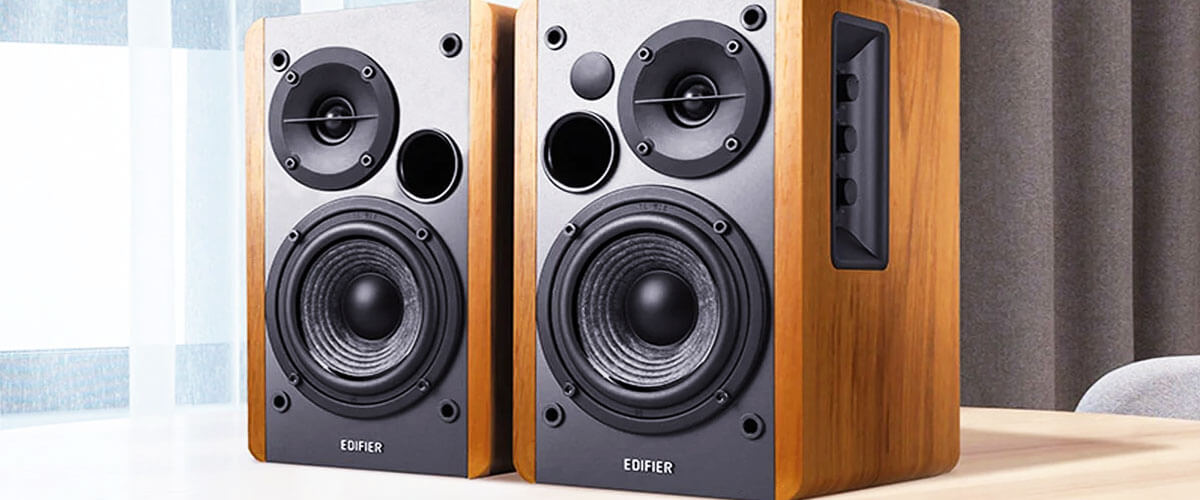
Now, about where they sit. Turns out that placement is pretty important. At ear level, they sing but put them lower, and it’s like they’re holding back. It’s a quirky trait that just adds to their character.
Another gripe is that the power switch is at the back. It’s not a deal-breaker, but it’s a bit awkward to reach after you’ve got everything set up just right.
In conclusion, the Edifier R1280T speakers are a solid companion for the Audio-Technica LP60X. They’re not about to redefine your audio experience, but for their asking price, they offer a blend of style, performance, and adjustability that’s hard to ignore. They’re perfect for those chilled-out listening sessions where the vibe of the room matters just as much as the music itself.
Key specs
- Power type: active.
- Output peak power: 42W.
- Speakers type: bookshelf.
- Frequency response: 52Hz-20kHz.
- Sensitivity: 85dBA.
- Connectivity: wired, wireless (Bluetooth).
- Dimensions, inch/cm: 9.5×5.7×6.5/24.1×14.5×16.5.
- Weight, lb/kg: 10.8/4.9.
Pros
- Stylish classic wood finish and durable build.
- Good sound for the price; fills a room well.
- Customizable sound with treble and bass adjustments.
Cons
- Bass can dominate over mids and highs.
- Distortion at high volumes.
- Must be placed at ear level.
- On/off switch placement is inconvenient.
Audioengine A5+
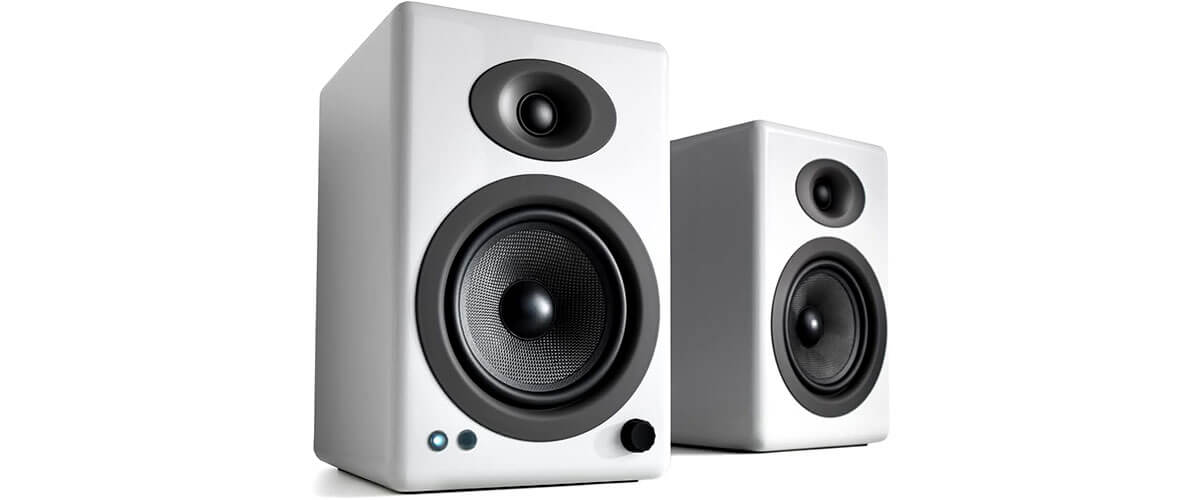
If you pair your Audio-Technica LP120 turntable with speakers, the Audioengine A5+ could be a consideration, blending a mix of sleek design and solid sound performance. On the surface, these speakers catch the eye with a modern look, although their finish might trick some into thinking they’re less sturdy than they actually are. Setting them up is straightforward, which is a plus if you want to avoid the fuss of extra equipment. Besides, the speakers are versatile – with aptX HD Bluetooth, USB, and analog AUX input options, you can connect a wide range of audio sources.
The A5+ delivers a warm and clear listening experience, making music feel immersive. That said, those with a preference for bass-heavy genres might find the bass output from the 5″ drivers a bit lacking. I added a subwoofer to round out the lower end; however, it’s an additional step and expense.
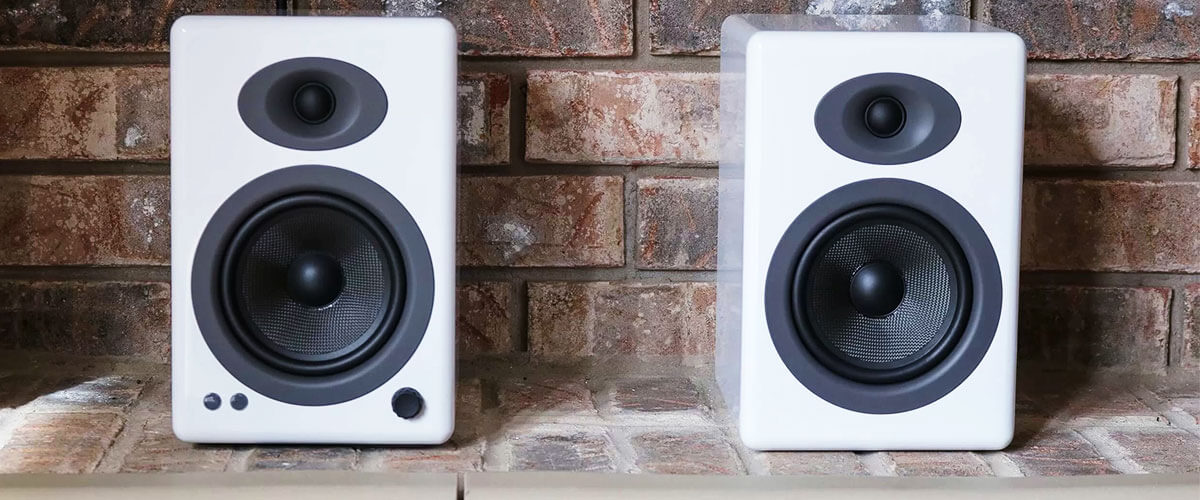
The energy-saving feature on these speakers seemed like a good idea at first glance, but it’s got its quirks. That sudden “pop” noise when they decide to take a nap? Yeah, it can give you quite the jump, especially when you’re not expecting it. And if you enjoy winding down at night with some soft music, having to suddenly crank up the volume just to wake your speakers back up isn’t exactly ideal. Plus, the power button’s awkward spot at the back has me fumbling around more than I’d like to admit.
To wrap up, the Audioengine A5+ speakers are a decent option for Audio-Technica LP120 owners looking for quality sound and a stylish look. They excel in many areas but aren’t without their flaws, particularly regarding bass performance and some design choices. They’re worth considering, but it’s wise to weigh these points carefully against your specific needs and listening habits. With the added benefits of aptX HD Bluetooth, USB, and a class AB amplifier, the A5+ offers a comprehensive package for users who value both form and function.
Key specs
- Power type: active.
- Output peak power: 150W.
- Speakers type: woofer,tweeter.
- Frequency response: 50Hz-22kHz.
- Sensitivity: 95dBA.
- Connectivity: wired, wireless (Bluetooth).
- Dimensions, inch/cm: 22×11.5×15/56×29×38.
- Weight, lb/kg: 31/14.
Pros
- Solid build.
- Straightforward setup.
- Good sound.
- Versatile USB, aptX HD Bluetooth, and AUX inputs.
Cons
- Bass may lack depth for some genres.
- The power-save feature can be inconvenient.
- Awkward power button placement.
Passive speakers
Klipsch RP-600M II – passive

Exploring the Klipsch RP-600M speakers, you’re hit with that classic Klipsch blend of old-school charm and something decidedly modern. When you spend some time with them, they reveal a character that’s notably appealing to those who cherish vinyl’s warm, analog sound.
The RP-600 M’s design is understated yet elegant. Its flashy aesthetics don’t demand attention, but its ebony and walnut finishes offer a refined touch to any setting. The build quality strikes a balance between lightweight and durable, indicative of Klipsch’s quality but without the heft that characterizes some of its competitors.
These speakers bring something vibrant to the table. The combination of a Tractrix horn-loaded tweeter and a Cerametallic bass/mid driver delivers a lively and engaging sound. The bass really catches your attention with its punchiness; it kind of wraps the music in a layer that feels deeper and more alive, like it’s happening right in front of you – a trait that’s particularly enjoyable for fans of energetic genres.
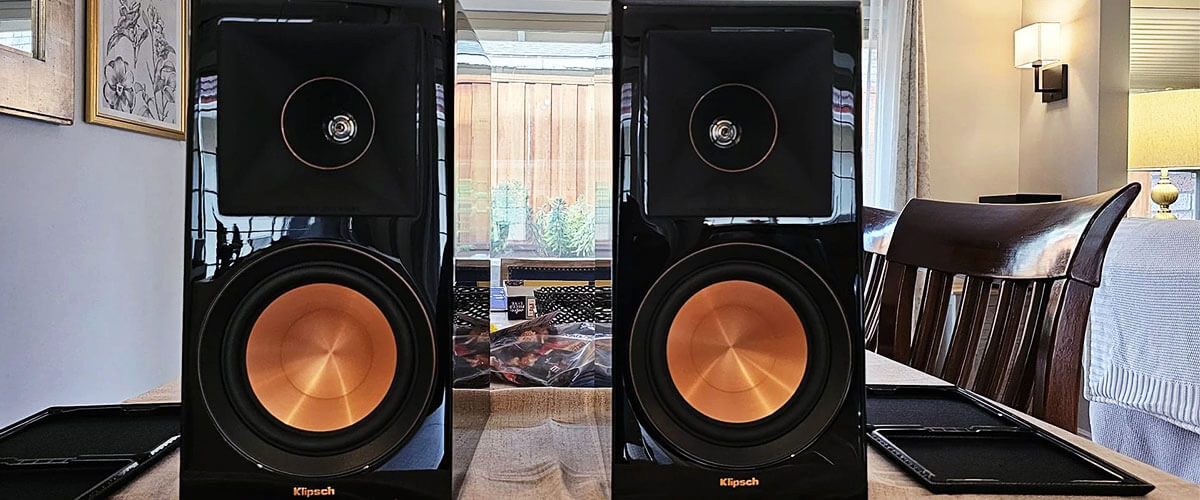
However, the monitors are not without their limitations. They tend to overemphasize the upper bass, which might obscure the details in complex musical arrangements. Additionally, although the tweeter is generally clear, it can sometimes lean towards harshness, reflecting a bit of its more assertive heritage.
Positioning the RP-600M thoughtfully in your space can enhance their performance. Keeping them a bit away from walls and angling them slightly can improve both bass output and stereo imaging. It’s pretty cool how adaptable they are, too – whether you’re hooking them up to a solid-state amp or a vintage tube model, they just seem to get along with everything.
In conclusion, the Klipsch RP-600M blends vintage charm with modern performance, making them great speakers for Audio-Technica turntable users. Their elegant design, vibrant sound, and versatility in setup ensure a rich listening experience despite some minor quirks.
Key specs
- Power type: passive.
- Output peak power: 400W.
- Speakers type: bookshelf, woofer.
- Frequency response: 45Hz-25kHz.
- Sensitivity: 96dBA.
- Connectivity: coaxial.
- Dimensions, inch/cm: 15.7×7.9×11.8/39.9×20.2×30.1.
- Weight, lb/kg: 16/7.3.
Pros
- Attractive design.
- Vibrant sound with punchy bass.
- Versatile, pairs well with different amps.
Cons
- Upper bass can overshadow details.
- Position-sensitive for best audio quality.
KEF Q150 – great alternative
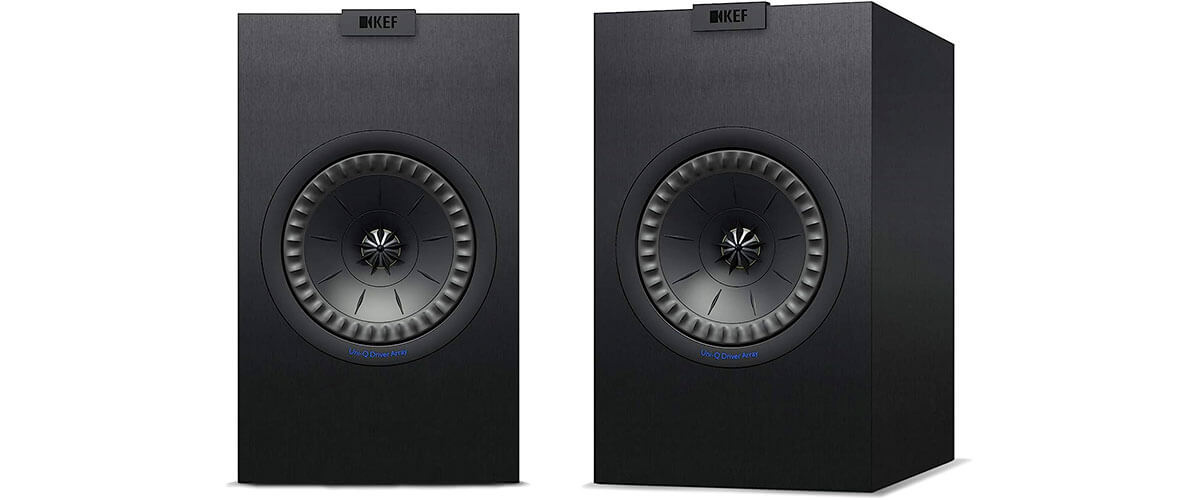
If you can’t stretch your budget to buy the Klipsch RP-600M II, the KEF Q150 is a good, cheaper alternative. My initial impressions were skeptical due to their boxy appearance in pictures, but seeing them in person changed my mind – they actually look quite sharp and carry an air of elegance that their price doesn’t immediately suggest.
The unique feature of these speakers is the 5.25” Uni-Q driver, which aims to enhance the listening experience by evenly dispersing sound. Additionally, moving the front port to the back is an interesting design choice that influences how they interact with the room around them.
Listening to the KEF Q150s, you’ll find their performance can be a bit of a mixed bag. There are moments when they sound absolutely incredible, delivering on the promise of high-quality audio that rivals more expensive models. However, there are also times when they’re just okay, and this inconsistency can depend heavily on what you’re listening to or even the specific recording.
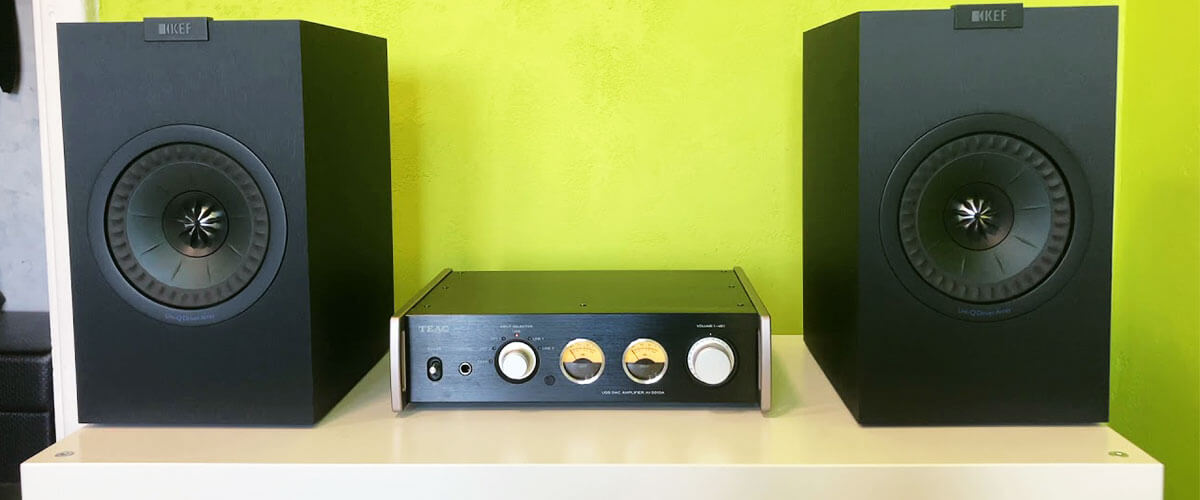
One of the Q150’s strengths is its bass response. Unlike many speakers in its price range, I didn’t wish for a subwoofer. The bass is substantial enough for my tastes, which is a significant plus. However, it’s worth noting that these speakers really come alive at higher volumes. They’re not the finest choice for late-night listening at low volumes; they demand a bit of power to truly shine.
To wrap things up, The KEF Q150 speakers offer solid audio performance at a more affordable price point, surprising with unusual design and satisfying bass. However, their sound quality shines at higher volumes, making them less ideal for low-volume listening.
Key specs
- Power type: passive.
- Output peak power: 100W.
- Speakers type: bookshelf.
- Frequency response: 51Hz-28kHz.
- Sensitivity: 86dBA.
- Connectivity: wired.
- Dimensions, inch/cm: 12×7.1×10.9/30.7×18×27.8.
- Weight, lb/kg: 12.3/5.6.
Pros
- Satisfying bass without needing a subwoofer.
- Uni-Q driver disperses sound evenly.
Cons
- Performance varies by music genre and recording.
- Not ideal for low-volume listening.
- The boxy design may not appeal to everyone initially.
Key features to look for in speakers for Audio-Technica record players
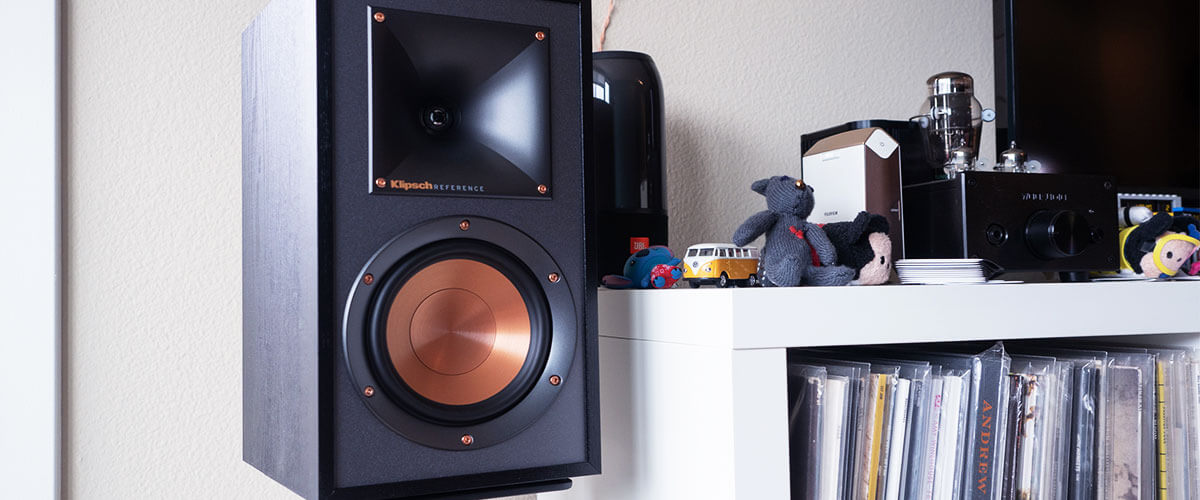
Frequency response
This metric measures a speaker’s ability to reproduce the range of sounds from the deep bass to the shimmering highs. For an immersive vinyl listening experience, aim for dynamics that boast a wide frequency range, ideally spanning from 20 Hz to 20 kHz, to capture the full auditory spectrum of your records. However, the integrity of your music depends not just on reaching these extremities but on delivering them with consistency and precision across the board. A speaker system that maintains this balance ensures your vinyl collection is heard in all its intended glory.
Impedance and power handling
These two characteristics are critical yet often overlooked aspects. Impedance, measured in ohms, indicates how much resistance a speaker offers to the flow of electrical current from your amplifier. Matching the impedance of your speakers and the amplifier ensures efficient power usage and optimal sound quality.
On the other hand, power handling defines how much power a speaker can handle without distortion or damage. Look for models whose power-handling capabilities align with your amplifier’s output to avoid any risk of overpowering or underutilizing them. Together, these specs ensure a harmonious setup that delivers clear, dynamic sound across all volumes.
Connectivity options
When setting up your Audio-Technica turntable, figuring out how you’ll connect your speakers is just as pivotal as the sound quality they offer. These days, the spectrum of options ranges from traditional cables like RCA and AUX, which ensure a clean, direct audio path, to the liberating convenience of Bluetooth and Wi-Fi for effortless streaming. Personally, I’m a bit of a purist and tend towards cables for that undiluted vinyl sound, but the appeal of wireless freedom is undeniable. It’s really about marrying the old with the new. So, when choosing your speakers, think about your listening habits. Looking for versatility? Aim for models equipped with a variety of connection options, making sure you’re covered for any musical situation, cable-free or otherwise.
We are supported by our audience. When you purchase through links on our site, we may earn an affiliate commission at no extra cost to you.
Our newsletter
* We will never send you spam or share your email with third parties

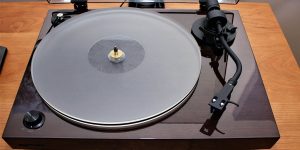

![Best Turntables Under $100 [Reviewed and Tested]](https://righttechadvice.com/wp-content/uploads/2023/09/best-turntable-under-100-300x150.jpg)
![Best Turntables Under $300 [Reviewed and Tested]](https://righttechadvice.com/wp-content/uploads/2023/10/best-turntable-under-300-review-300x150.jpg)
![Best Record Players Under $200 [Reviewed and Tested]](https://righttechadvice.com/wp-content/uploads/2023/10/best-turntable-under-200-300x150.jpg)
